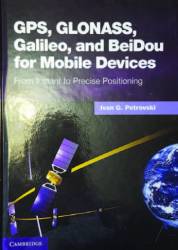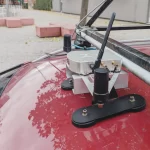
The navigation sensors for location-based services (LBS) are complex technical systems. Modern technical science can answer most questions about the optimality of particular position determination methods, signal processing algorithms, electronic circuits or similar well-defined problems, but the rigorous answer to the questions concerning the optimal LBS positioning sensor are still a big problem.
The navigation sensors for location-based services (LBS) are complex technical systems. Modern technical science can answer most questions about the optimality of particular position determination methods, signal processing algorithms, electronic circuits or similar well-defined problems, but the rigorous answer to the questions concerning the optimal LBS positioning sensor are still a big problem.
Ivan Petrovski’s book presents not only LBS navigation sensors based mainly on satellite navigation systems (GNSS) and software radio, but also it provides valuable insight from their practical implementation. GPS, GLONASS, Galileo, and BeiDou for Mobile Devices, From Instant to Precise Positioning is written for satellite navigation experts. It summarizes the latest knowledge of mobile GNSS devices’ design and applications as well as the opinion of the author on the realization of the particular problems in the area of the GNSS signal processing and software radio, all based on his deep experience.
In contrast to Dr. Petrovski’s previous book, Digital Satellite Navigation and Geophysics, or Bernard Hoffmann-Wellenhof’s GNSS-Global Navigation Satellite Systems — GPS, GLONASS, Galileo & More, the valuable information is not placed in a wider context; so, beginners could easily lose their orientation.
The book is introduced by an inspired foreword to location-based services by Glen Gibbons. The 312 pages of the book are then organized into four parts as follows:
The first part describes advanced knowledge of navigation satellite position calculations, satellite navigation signals, and stand-alone and reference station–based GNSS positioning. The most valuable parts are modeling of the signal propagation effects and carrier phase positioning.
The second part deals with the conventional and software GNSS receivers. There is a lot of practically usable information such as advice on how to design high- or super-high–sensitivity receivers, how to optimally implement GNSS correlators to the general purpose processor and many others.
The third part addresses the essential LBS relative positioning methods including assisted-GNSS, real-time kinematic, differential GNSS, and pseudolites as well as instant BGPS (developed by Dr. Petrovski and others), precise point positioning, and snapshot methods. The presented text is not limited to describing those methods, but the author also gives practical examples of applications and provides recommendations for their implementation. Very well written is the last chapter, “Trends, Opportunities and Prospects,” in which Ivan Petrovski predicts convergence of the mobile and geodetic applications and tight integration with the Internet.
The last part deals with the GNSS receiver and LBS sensor testing. I personally use the IP-Solutions ReGen GPS simulator developed by the author for testing of LEO satellite GPS receivers. I fully agree with his attitude that the software GNSS simulators have good prospects and, thanks to the increased performance of general purpose processors, they will become a full-blown alternative to standard software-designed radio (SDR) simulators.
This book is definitely a valuable source of information for development, optimization, and testing of GNSS signals and data processing algorithms and their implementation to the software radio for mobile, indoor, and high-grade receivers.
GPS, GLONASS, Galileo, and BeiDou for Mobile Devices, From Instant to Precise Positioning
By Ivan G. Petrovski, Cambridge University Press, 2014, ISBN 978-1-107-03584-3






